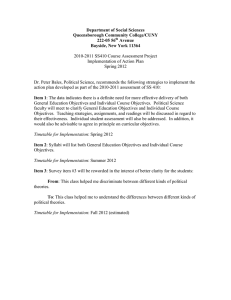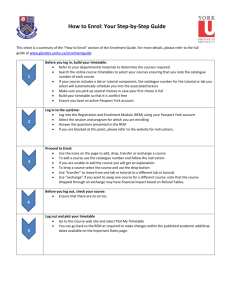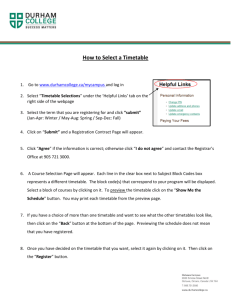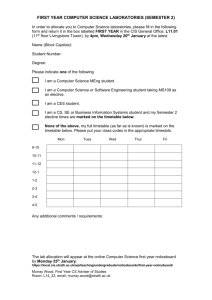Tutorial 5 Lesson planning (a)
advertisement
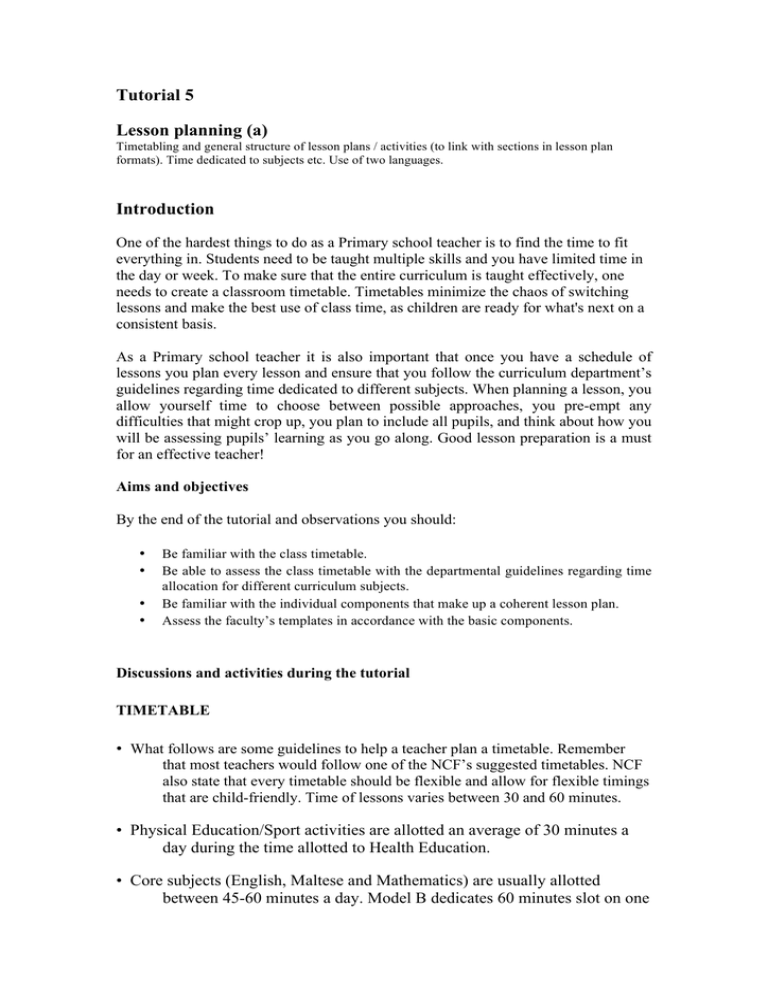
Tutorial 5 Lesson planning (a) Timetabling and general structure of lesson plans / activities (to link with sections in lesson plan formats). Time dedicated to subjects etc. Use of two languages. Introduction One of the hardest things to do as a Primary school teacher is to find the time to fit everything in. Students need to be taught multiple skills and you have limited time in the day or week. To make sure that the entire curriculum is taught effectively, one needs to create a classroom timetable. Timetables minimize the chaos of switching lessons and make the best use of class time, as children are ready for what's next on a consistent basis. As a Primary school teacher it is also important that once you have a schedule of lessons you plan every lesson and ensure that you follow the curriculum department’s guidelines regarding time dedicated to different subjects. When planning a lesson, you allow yourself time to choose between possible approaches, you pre-empt any difficulties that might crop up, you plan to include all pupils, and think about how you will be assessing pupils’ learning as you go along. Good lesson preparation is a must for an effective teacher! Aims and objectives By the end of the tutorial and observations you should: • • • • Be familiar with the class timetable. Be able to assess the class timetable with the departmental guidelines regarding time allocation for different curriculum subjects. Be familiar with the individual components that make up a coherent lesson plan. Assess the faculty’s templates in accordance with the basic components. Discussions and activities during the tutorial TIMETABLE • What follows are some guidelines to help a teacher plan a timetable. Remember that most teachers would follow one of the NCF’s suggested timetables. NCF also state that every timetable should be flexible and allow for flexible timings that are child-friendly. Time of lessons varies between 30 and 60 minutes. • Physical Education/Sport activities are allotted an average of 30 minutes a day during the time allotted to Health Education. • Core subjects (English, Maltese and Mathematics) are usually allotted between 45-60 minutes a day. Model B dedicates 60 minutes slot on one of the days for Maltese and on another day for English. Mathematics is allotted 45 minutes per day in all three models. In the allotted time for languages (English and Maltese) children should be exposed to the four language skills: Listening, speaking, reading and writing. As for Mathematics children should develop the four strands, namely, use of numbers, measurement, space and shapes and data handling and engagement with investigative processes that lead to solutions (problem solving). • The main learning area that should feature in the Primary school timetable are the following: Languages (Maltese and English), Mathematics, Science, Religious Education, Citizenship Education (History, geography, social studies and environmental education), technology education, art education, Health Education (physical education and PSD) Tutorial Activity 1 Before this tutorial ask your collaborating teacher to give you a list of school activities for the term that will be affecting the contact time with your class. During the tutorial discuss these activities and how they would be affecting your weekly timetable. Discuss also which lessons would you sacrifice for these activities. Tutorial Activity 2 Ask your collaborating teacher to give you a copy of her timetable. Compare and contrast this timetable with those suggested in the NCF document (see below). Discuss with your tutor the differences and how this affects the teaching and learning of each learning area. Are all the above-mentioned learning areas included in the teacher’s timetable? How are the different learning areas presented in the teacher’s timetable? Tutorial Activity 3 Use the list of school activities and mid-week public holidays and draw up a detailed schedule of lessons for a month. Eventually you need to be able to plan in this manner for the whole term. LESSON PLAN A lesson plan should include the following compulsory sections: • Clear objectives or learning outcomes. • Duration of the lesson • A focused introduction (focus student attention, share the objectives of the lesson and establish purpose) • Instruction (Provide information, explain concept, state definitions, identify main ideas, check for understanding, create ways for participation) • Guided practice (create directed activities, provide feedback and more independent activities, monitor student work) • Closure (Summarize the learning and whether all students met the state outcomes, final check) • Independent practice (written work, homework) • Accommodations for specific students. Tutorial Activity 4 Analyse the lesson plan templates suggested by the department of Primary education and discuss how these templates incorporate or not the above compulsory components. How does each model differ from the others? Observation Session 1. Take a detailed log of all the activities, lessons etc. that take place during the day you are observing. You may use the below schedule to help you login all the occurrences. Discuss with the teacher whether this is a usual day and if so, how does she emend to ensure that the children receive their fair complement of curricular allotment. Time Activity Comments (In this section, amongst other things you should also indicate the language used – English/Maltese or codeswitching) 2. Ask the class teacher to give you a sample of her lesson plan/s and analyse it for the above stated compulsory components. Observe how closely the teacher follows her lesson plan in the delivery of the lesson. 3. Observe the extent of use of the textbook during the lesson and what other texts and resources are used by the teacher. Post-Observation Session 1. Discuss with your tutor the above log and the discussions you had with your collaborating teacher. 2. Focus on the language used for the various lessons and activities and discuss the value of such decisions. 3. Discuss with your tutor the lesson plans observed. Focus on the structure of the lesson and the texts and resources used. Appendix 1 (Please refer only to the table) 75$85*//0,$9,*.)+:+)+0&,;4+.4,705/+)&,&'99+.+0%),)+/0,9$5,)40,<+99050%),(0*5%+%8,*50*&= 6FKRROVDUHWRHQVXUHWKDWKRXUVSHUZHHNDUHVSHQWRQWHDFKHUSODQQLQJVHVVLRQVDW &.4$$(= ,QOLQHZLWKWKHIOH[LELOLW\ZKLFKWKH1&)LVSURSRVLQJRQHRIWKHWLPHWDEOHRSWLRQVVHWV *&+<0,$%0,4$'5,705,;00>,?*775$@+/*)0(6,1",4$'5&,705,60*5A,9$5,B0*<&,*%<,C.4$$(&,)$, <0.+<0,4$;,)4+&,)+/0,+&,)$,D0,&70%)=,E%,F$<0(,#,&4$;%,D0($;G,)4+&,)+/0,+&,<0&+8%*)0<, *&,!"#$$%&'()*+,-#$."*=,H+)4,6$'%805,.4+(<50%G,;4050,)4050,+&,%$,9$50+8%,(*%8'*80,*;*I 50%0&&,75$85*//0,?J1AG,)40,&.4$$(,4*&,*%,*<<0<,<08500,$9,9(0@+D+(+)6=,E),+&,4$70<,)4*), 9(0@+D+(+)6,+%,)40,)+/0)*D(0,;+((,+%.50*&0,$:05,)+/0= !"#$%&''()&*$+%*(%'$&,-"-.%&,$&/ 3*D(0,",750&0%)&,)4500,/$<0(&,+%<+.*)+%8,)40,;00>(6,<+&)5+D')+$%,$9,)+/0,9$5,K0*5,L,*%<M $5, K0*5, N, .(*&&0&, <070%<+%8, $%, ;40%, )40, O$50+8%, J*%8'*80, *;*50%0&&, 75$85*//0, +&, +%)5$<'.0<=, 3*D(0,1,750&0%)&,*%,0@*/7(0,$9,;4*),)40,*%%'*(,<+&)5+D')+$%,$9,)+/0,9$5,*,K0*5,N,.(*&&,;$'(<, D0,$%,)40,D*&+&,$9,0*.4,$9,)40,*D$:0,/$<0(&=,34+&,8+:0&,*%,+%<+.*)+$%,$9,)40,*775$@+/*)0, )+/0,*:*+(*D(0,9$5,0*.4,(0*5%+%8,*50*,*%<,)40509$50,%00<&,)$,D0,)*>0%,+%)$,.$%&+<05*)+$%, ;40%,&6((*D+,9$5,)40,(0*5%+%8,*50*&,*%<,&'DP0.)&,*50,D0+%8,<0:0($70<=, Q770%<+@, E, +%.$57$5*)0&, /$<0(, )+/0)*D(0&, *..$5<+%8, )$, )40, &'880&)0<, <+&)5+D')+$%, $9, (0*5%+%8,)+/0,&4$;%,+%,3*D(0&,",*%<,1= "!" %-5. /&315/&31 050 /&315/&31 / ,&1, ,&1, ,&31 /&31 1 0&1 . -&1 -&1 " ,&31 ,&31 ,&31 .&1 .&1 .&1 # .&.1 -&1 -&1 .&.1 -&1 -&1 /&1 /&31 /&1 ' ' ' - "$ "$ "$ ' '" - " -&.1 .&1 (-&1) -&.1 -&.1 .&1 (-&1) -&.1 -&.1 .&1 (-&1) -&.1 #! #! #! !" # "(/.!) #$%&'()*)+$%,-$.'/0%),12,340,34500,#6.(0& -5. -.,5-., -.45-.4 -.,5-., / -2 -2 .0 -., -2, -00 20 04 04 " .0 .0 .0 4, 4, 4, # 3. 04 04 3. 04 04 --. -., --. ' ' ' /. ! !!!!!!!!!!!!!!!!!!!!!!!!!!!!!!!!!!!!!!!! !!!!!!!! - " -&1$ Appendix 2: Model timetables for primary school !""#$%&'()*( #$%&'()*)+$%,-$.'/0%),12,340,34500,#6.(0& !"#$%&'()$'*+%$,&-".&/.()*.0&,12""%,&*11".#(34&'"&,544$,'$#& #(,'.(+5'("3&"-&%$*.3(34&'()$&(3&6*+%$,&7&*3#&8 !" ! #$$%&'()*+ !" ! !" #$%&'()*)+$%,-$.'/0%),12,340,34500,#6.(0& Appendix 3: Lesson plan templates Find attached with email
